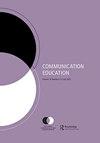传播学教育研究的绝对状态:面对汉龙剃刀
IF 0.8
Q3 COMMUNICATION
引用次数: 0
摘要
有机会写评论、自我评价或议程设定论文,也许是学术界最大的虚荣心之一。很少有人承认,写这些文章的学者本身,往往是制造这个问题的那群人中的一员。相反,作者常常带着一种傲慢的态度写作,认为他们的学术干预将会拯救世界。因此,在写这篇文章时,我带着些许不安。我并不自诩拥有上帝的视角,也不是普罗米修斯的引火者——我承认我的学识对我将要讨论的一些问题有所贡献。然而,我确实得到了一些安慰,因为我知道这篇文章增加了(在这个论坛和期刊内外)的声音合唱,他们试图解决沟通和教学学术的质量,方向和基调。事实上,在准备这篇文章的时候,我对过去30年里出现的这种类型的文章数量感到震惊。与此同时,尽管有这些请求,但情况几乎没有改变。我们的研究领域缺乏实质性的变化,这引出了一个问题:是什么阻碍了我们的学术团体前进?在这里,我们可以采用汉隆剃刀来探索我们的失败是由于愚蠢还是恶意(Bloch, 2003)。而且,恕我直言,我认为(从历史的角度来看)在这种情况下,我们最好的答案是后者。也就是说,我们没有看到它的原因是因为我们领域内的许多人这样做并不符合自身利益。长期以来,有问题的研究设计、方法论排斥和空洞的研究结果被认为是正常的。当传播教育被以这些失败为特征的研究所主导时,它变成了一个自我强化的循环:当简单的工作可以在该学科最负盛名的期刊上发表时,为什么要花费资源去做优秀的研究呢?这个问题反过来又产生了一群极端狭隘、自我祝贺和自我防御的学者,他们通过推动那些继续接受低质量奖学金(作为审稿人或编辑)的人的职业生涯来保持自己在这个渠道的主导地位,并期望他们在提交时(作为作者)能得到回报。在许多方面,我们今天处理的方法论问题是那个时代惯性的结果,它创造了一种文化,在这种文化中,高质量的研究仍然是例外,而不是规则。因此,我的观点是,我们的领域必须打破过去学者们所开辟的平庸之路,创造一种创造和奖励的文化本文章由计算机程序翻译,如有差异,请以英文原文为准。
The absolute state of research in Communication Education: facing Hanlon’s Razor
The opportunity to write critiques, self-appraisals, or agenda-setting essays is perhaps one of the great vanities of academia. That the scholars who write them are often, themselves, a part of the very group of people who created the problem is rarely acknowledged. Rather, authors often write with the hubris that their scholarly intervention will be the one to save the day. It is, therefore, with some trepidation that I write this essay. I make no pretensions to possessing a God’s eye view nor being a Promethean fire-bringer—I recognize my scholarship has contributed to some of the problems I will discuss. However, I do take some solace in knowing that this essay adds to a chorus of voices (within and beyond this forum and journal) who have sought to address the quality, direction, and tone of communication and instruction scholarship. In fact, in preparing for this response, I was struck by how many of these types of essays have been written over the past 30 years. And, simultaneously, how little has changed despite these pleas. The lack of substantive change in our field begs the question: what has prevented our scholarly community from advancing? Here, we might adopt Hanlon’s Razor to explore whether our failure to progress is due to stupidity or malice (Bloch, 2003). And, with all due respect to the adage, I think (historically speaking) our best answer is the latter in this case. That is, the reason we have not seen it is because it was not in the self-interest of many within our field to do so. Questionable research designs, methodological exclusion, and vacuous findings were accepted as normal for far too long. As Communication Education became dominated by research characterized by these failings, it became a self-reinforcing loop: why spend the resources to do excellent research when unsophisticated work would be published in one of the most prestigious journals of the discipline? This problem, in turn, produced a fiercely insular, self-congratulatory, and defensive group of scholars who maintained their dominance over this outlet by advancing the careers of others who would keep accepting poor-quality scholarship (as reviewers or editors) with the expectation that they would return the favor when they submitted (as authors). In many ways, the problems with methodology that we deal with today are the result of inertia from this time, which has created a culture where high-quality research remains the exception rather than the rule. My argument, then, is that our field must break out of the well-worn path of mediocrity blazed by the scholars of the past by creating a culture that produces and rewards
求助全文
通过发布文献求助,成功后即可免费获取论文全文。
去求助
来源期刊

COMMUNICATION EDUCATION
EDUCATION & EDUCATIONAL RESEARCH-
CiteScore
3.10
自引率
34.80%
发文量
47
期刊介绍:
Communication Education is a peer-reviewed publication of the National Communication Association. Communication Education publishes original scholarship that advances understanding of the role of communication in the teaching and learning process in diverse spaces, structures, and interactions, within and outside of academia. Communication Education welcomes scholarship from diverse perspectives and methodologies, including quantitative, qualitative, and critical/textual approaches. All submissions must be methodologically rigorous and theoretically grounded and geared toward advancing knowledge production in communication, teaching, and learning. Scholarship in Communication Education addresses the intersections of communication, teaching, and learning related to topics and contexts that include but are not limited to: • student/teacher relationships • student/teacher characteristics • student/teacher identity construction • student learning outcomes • student engagement • diversity, inclusion, and difference • social justice • instructional technology/social media • the basic communication course • service learning • communication across the curriculum • communication instruction in business and the professions • communication instruction in civic arenas In addition to articles, the journal will publish occasional scholarly exchanges on topics related to communication, teaching, and learning, such as: • Analytic review articles: agenda-setting pieces including examinations of key questions about the field • Forum essays: themed pieces for dialogue or debate on current communication, teaching, and learning issues
 求助内容:
求助内容: 应助结果提醒方式:
应助结果提醒方式:


